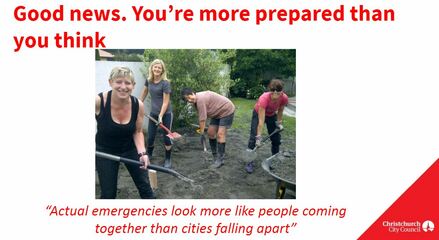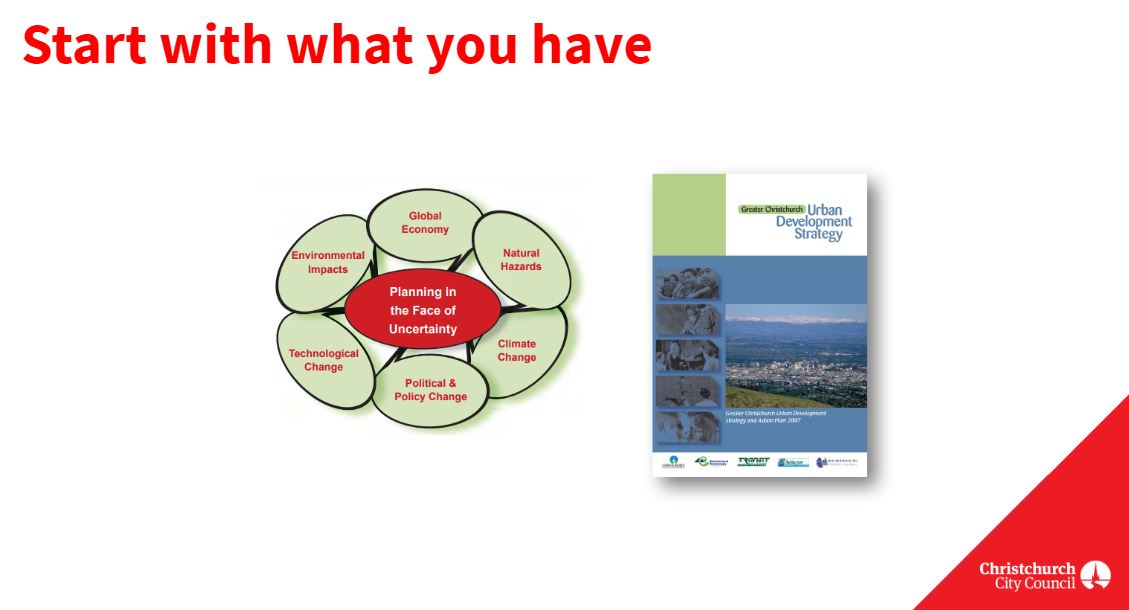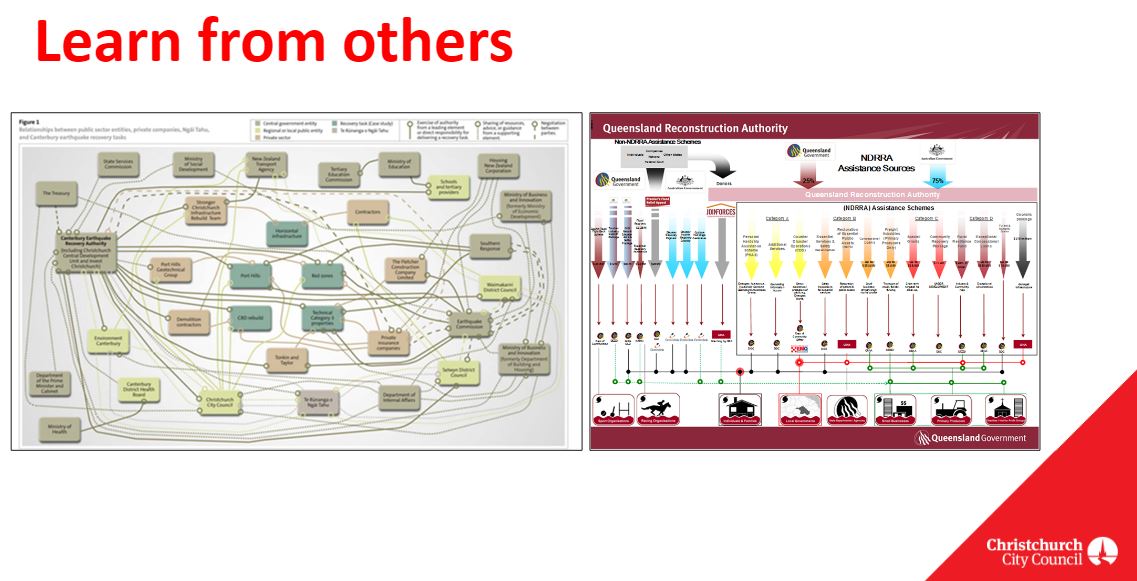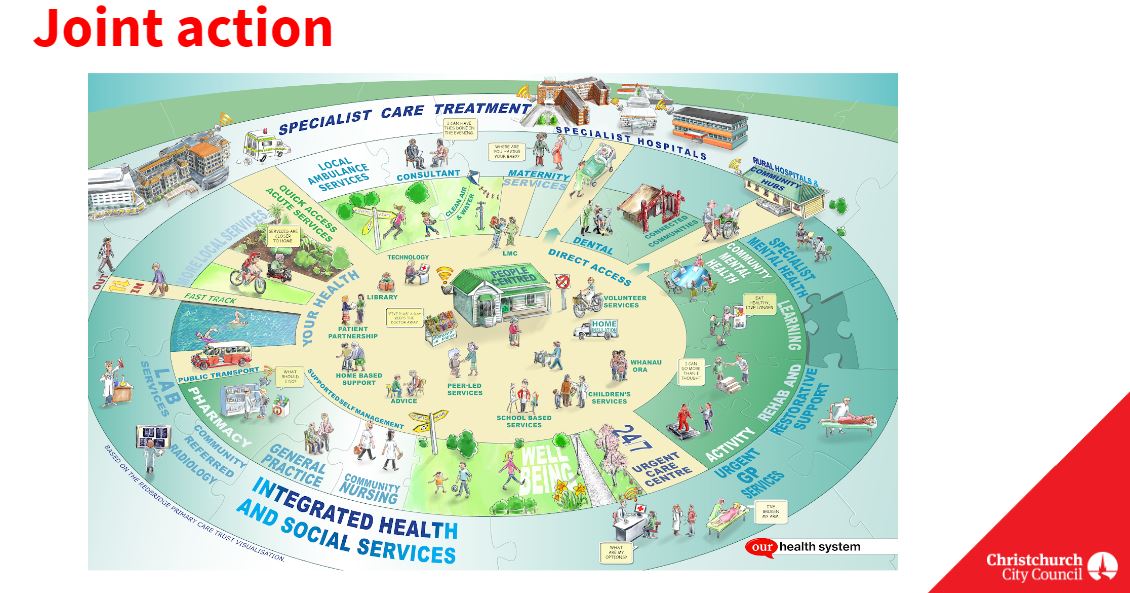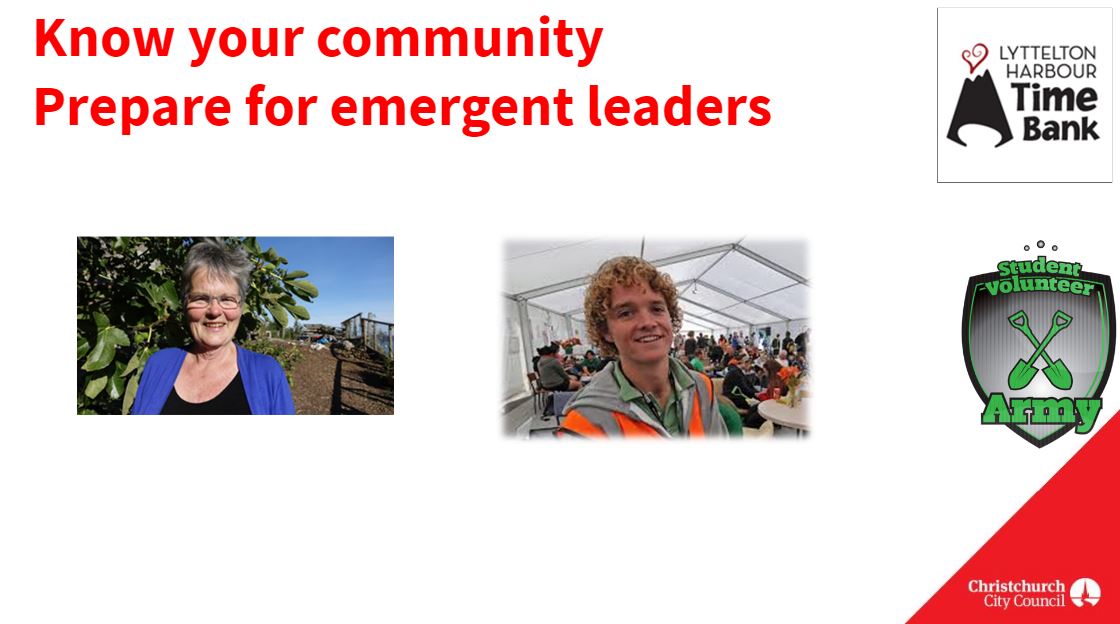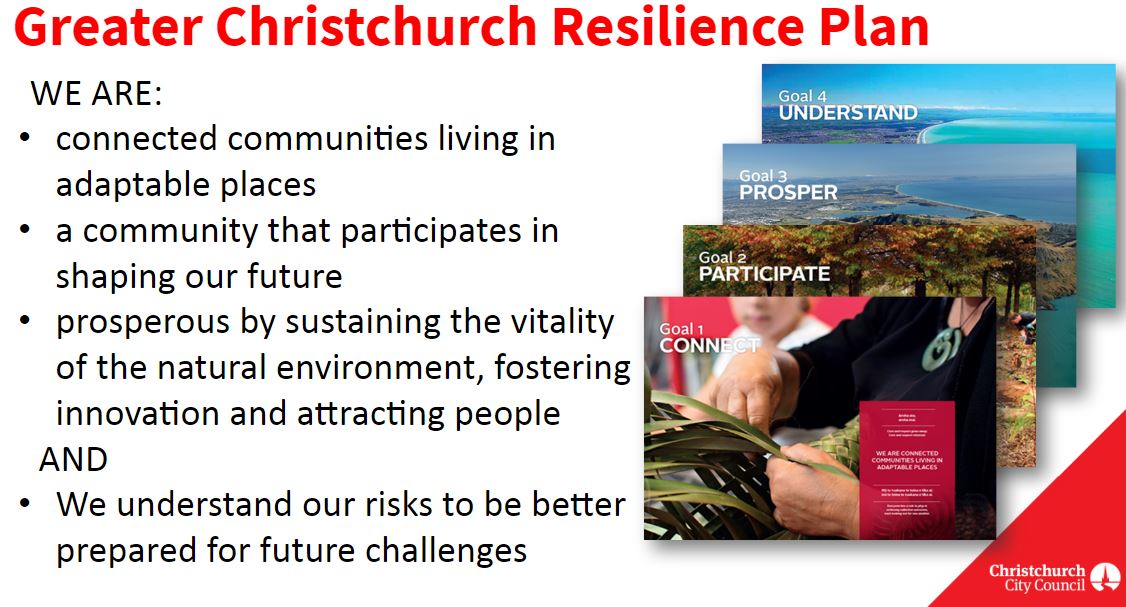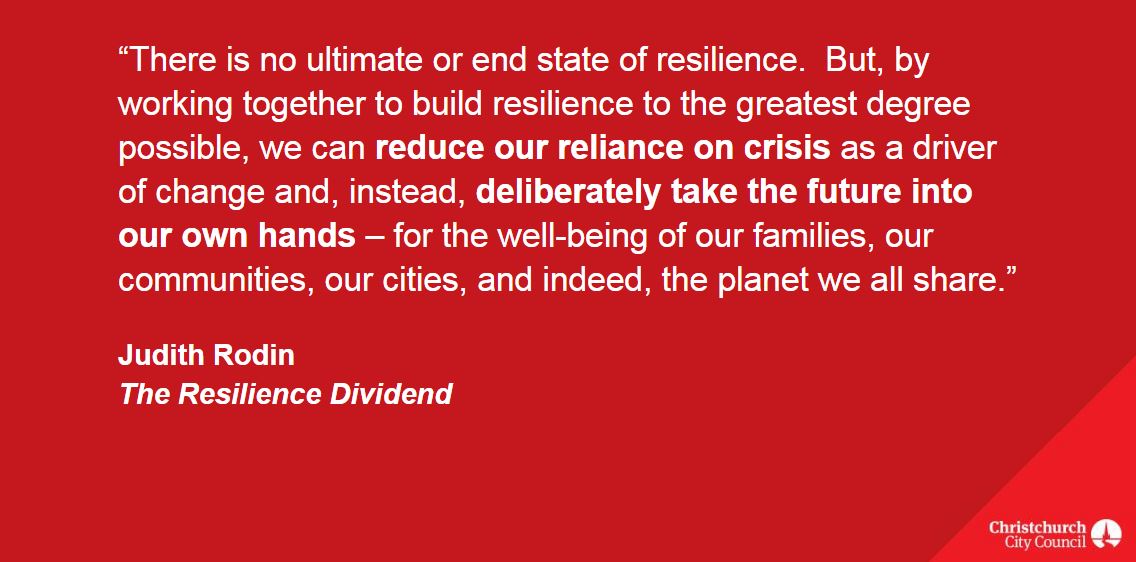It is also important to acknowledge the impact that the Canterbury Earthquake Sequence had on Christchurch, the two neighbouring Districts, and families across New Zealand and the world, whose loved ones were among the 185 people who died on 22 February 2011.
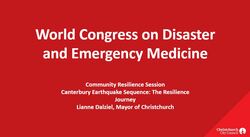
Thank you for inviting me to speak about the resilience journey in the context of the earthquakes we experienced.
Most people, who know me, will not be surprised that I am speaking about resilience. I have been a champion of resilience since I discovered what it truly meant when it comes to building the capacity of communities to prepare for an uncertain future. I remember the day when I realised that community development, climate change adaptation, disaster risk reduction and sustainable development were all part of the same resilience equation.
However when I use the word in some quarters I get a huge sigh and raised eyebrows – ‘here she goes again’. It’s not hard to understand why this happens. We in Christchurch have been described as resilient so many times since the earthquakes began, that we are frankly sick of it. And that’s because the appearance of withstanding the shock of disaster is not resilience; it’s the stoicism we are famous for in our region.
The ability to see through the word and capture the essence of its meaning is an essential part of the Resilience Journey that I want to speak to today. And I use the word journey deliberately – resilience is a journey, not a destination.
I also want to remind you how the active participation of connected communities is so vital. And that includes a few other messages:
• Start with what you have;
• Know your community;
• Prepare for emergent leadership, and
• Ensure the recovery process builds the capacity and capabilities of affected communities and local institutions.
And finally, learn from others and also learn the lessons of your experience and share them with others – what you got right and … yes….the mistakes as well.
If we and others learn from each other’s mistakes, we can save a lot of heartache in the future.
But please remember my latest saying: lessons are not learned until they are embedded into practice.
So onto resilience.
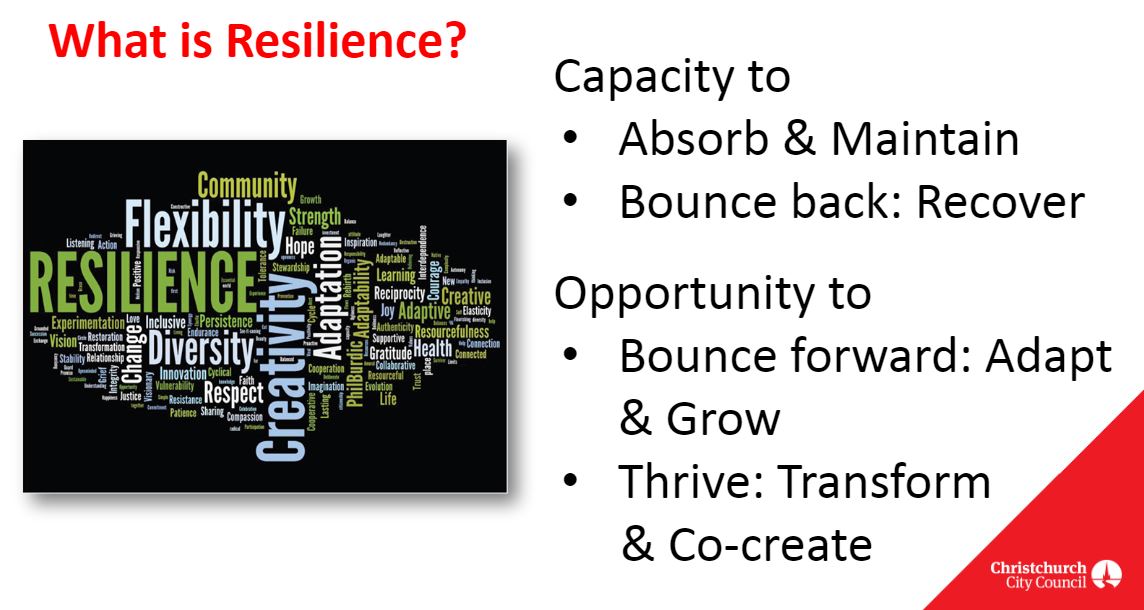
I put up this word cloud to remind us that resilience doesn’t mean strong – look at the words – flexibility, adaptation, creativity, diversity, community, respect, change, cooperation. It’s all there.
I always refer to the standard definition – the capacity to absorb and maintain system function in the face of catastrophic events – followed by the standard phrase to bounce back or to recover.
However I have come to understand resilience from a community perspective to mean much more than that. The opportunity to bounce forward was the first expression I heard used after the earthquake sequence began that introduced the concepts of adapting and growing. And then the word thrive – opening up the possibility of transformation and co-creation.
That requires trust – both ways – meaning decision-makers have to engage communities in decision-making in a meaningful way - and it requires communities to actively seek to take back responsibility for their futures. And that’s what’s hard.
But as luck has it, you’re always better prepared than you think.
The range of reviews, inquiries and reports that seek to identify lessons learned in terms of the Christchurch story have yet to be synthesised, but they must reflect these community-led elements as well as the pre-existing story – what was going on in Christchurch before the disaster that helped with the response and the recovery.
I heard someone talk about the importance of this at a recovery seminar in the context of identifying pre-existing vulnerabilities. You wouldn’t want to build them back. I now know it to be equally true of pre-existing strengths – they are the building blocks of recovery and resilience.
One of my messages today is how important it is to recognise these building blocks as preparedness initiatives when considering a Disaster Risk Management framework, because they can shape both the nature and the speed of recovery and build resilience at the same time. This is why I always say that the leadership for this has to be at the city and the town level.
Because if you don’t there is a risk that something new will be created and that does not build local resilience. There are enormous benefits to be found in existing collaborative relationships.
Don’t side-line them– repurpose them and build on them. The Greater Christchurch Urban Development Strategy already existed before the earthquakes. It was the perfect platform for a Recovery Strategy for the affected area and for the specific recovery plan for land use. We had already done the planning – we just needed to do a quick update and press the fast forward button. And there was the added advantage of a pre-existing Implementation Committee that brought all the relevant people to the table on a monthly basis.
Unfortunately that was not to be – new plans were written, a Recovery Strategy Advisory Committee was developed, and some of the pre-existing networks fell over as they had no purpose.
I had already learned about the risk that local leadership becomes secondary to a centrally imposed recovery framework. And I learned that here in Brisbane.
I visited the Queensland Reconstruction Authority back then – their message was to emphasise the importance of communication, communication, communication – something that is equally vital to genuine community engagement, understanding risk and building confidence at the same time as building trust.
However, as I said, the most important lesson for me (and well-supported by international evidence) was the need to strengthen and not hollow out existing institutions, networks and relationships, and build the recovery arrangements around those. This means that when the time comes to reduce the amount of central government involvement, you have a strong foundation for the future and significant local relationships have been left intact, and don’t need to be rebuilt from scratch.
With the home at the heart, primary, secondary and tertiary health services can be seen as part of the myriad aspects of life in the city – mutually reinforcing each other and able to be embraced by the local government sector and non-government organisations.
I often remind people that there was a small outbreak of H1N1 in a suburb in Christchurch prior to the earthquakes; it was fully contained and did not become the pandemic it could have been. Why?
We were already working collaboratively. Public health messages were everywhere – ‘wash your hands before eating’ signs were everywhere – schools and office buildings. Whose logo was on them? The Christchurch City Council. Joint action was required – not individual silos.
After the earthquakes we all noticed how the silos came down – some were already down and health promotion was one area where that was already the case. Just as an aside, we did all notice how easy it is for the silos to come back. It doesn’t take long.
Pamela Jeffries is from a group called Project Lyttelton. She was recognised last year in the Queen’s Birthday Honours list for the incredible work she has done in the port town of Lyttelton.
Project Lyttelton is a non-profit grassroots organisation committed to building sustainable, connected community. Their website says they aim to "be the change we wish to see in the world”.
Some of their projects include; supporting local food production, minimising waste and creating ways to re-use, reduce and recycle, creating opportunities for people to come together to play, share information and skill.
They run a Time Bank. I can tell you that you don’t need a civil defence team in a community with a time bank where community members respect each other’s contribution hour for hour not dollar for dollar.
Through a range of innovative projects, they have harnessed the power of community and fostered hope and inspiration to create a collective future. Their values-based approach is both inclusive and participative – and they recognise all people have intrinsic value. This is the heart of community resilience.
Sam Johnson was one of the founders of the Student Volunteer Army, which was established after the first earthquake in September 2010.
Sam, having had his offers to volunteer to help declined by both Civil Defence and Red Cross, due to his lack of volunteer training, posted on Facebook and the rest is history. The students came out in their droves and became our heroes, alongside the Farmy Army, that dug hundreds of thousands of tonnes of silt from our backyards and streets.
The spirit the SVA engendered has become an integral part of the University of Canterbury’s curriculum, and Sam has since set up a number of social enterprises, the latest being Community Guardians, which in collaboration with the city-owned company responsible for maintenance, has created meaningful volunteering opportunities for people to give back to their communities.
These are just two examples – there are many more. You may not know the Sam Johnsons, the emergent leaders, but you should know how to recognise them when they make their offer to help, and people like Pamela Jeffries, you should know them really well already.
Our resilience plan has four major goals:
• We are connected communities living in adaptable places
• We are a community that participates in shaping our future
• We are prosperous by sustaining the vitality of the natural environment, fostering innovation and attracting people
• We understand our risks to be better prepared for future challenges
There are many elements to achieving these goals but all of them are about mutual actions. And they all require engaging with the community in a meaningful way. Have we got that right yet? It’s still a work in progress and it is hard without the kind of local leadership that I have spoken of. But I’m not giving up because this truly is the opportunity that springs from disaster, and it meets all our strategic objectives as a Council.
Resilience is not a top down exercise, but nor is it from the grassroots alone. It has to be both.
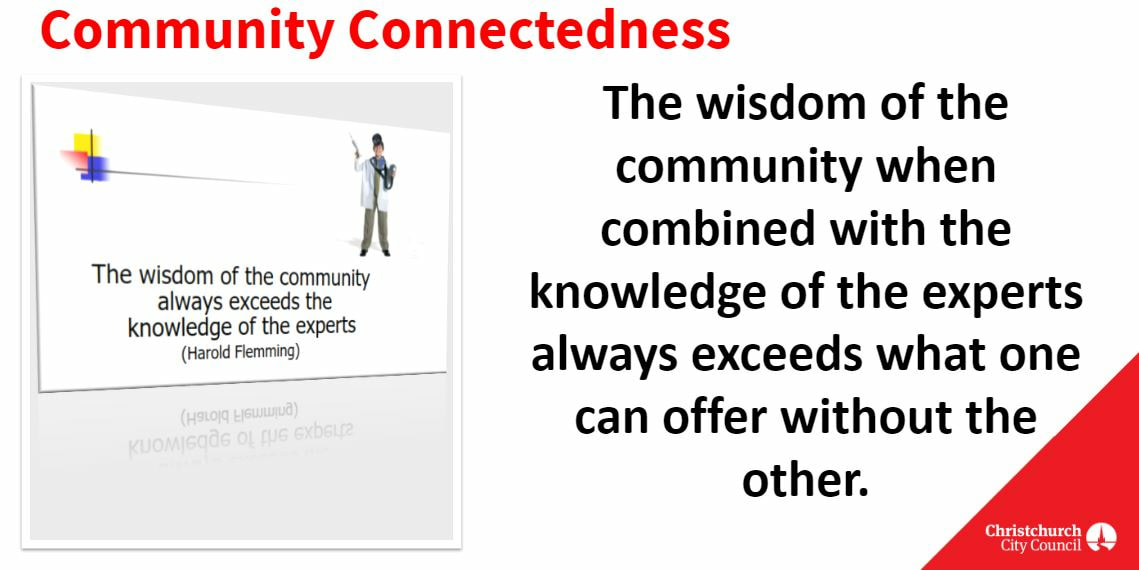
The motto which reads: “The wisdom of the community always exceeds the knowledge of the experts” reflected their utter frustration at being excluded throughout the response and the recovery journey.
Having been on the resilience journey, (CLICK) I would now say that the wisdom of the community when combined with the knowledge of the experts always exceeds what one can offer without the other.
And that’s why it’s so important to focus on community resilience. And my final slide says – we needn’t wait.
“There is no ultimate or end state of resilience.”
Again this is my point of resilience being a journey and not a destination. Judith goes on to say:
“But, by working together to build resilience to the greatest degree possible, we can reduce our reliance on crisis as a driver of change and, instead, deliberately take the future into our own hands – for the well-being of our families, our communities, our cities, and indeed, the planet we all share.”
Isn’t that a hopeful and challenging way to end this presentation?
No-one needs to wait for a crisis to do that if we truly learn the lessons of the Christchurch experience and that’s why I will continue to talk about the resilience journey whenever I can, and the importance of always placing the community at the heart of all that we do.

